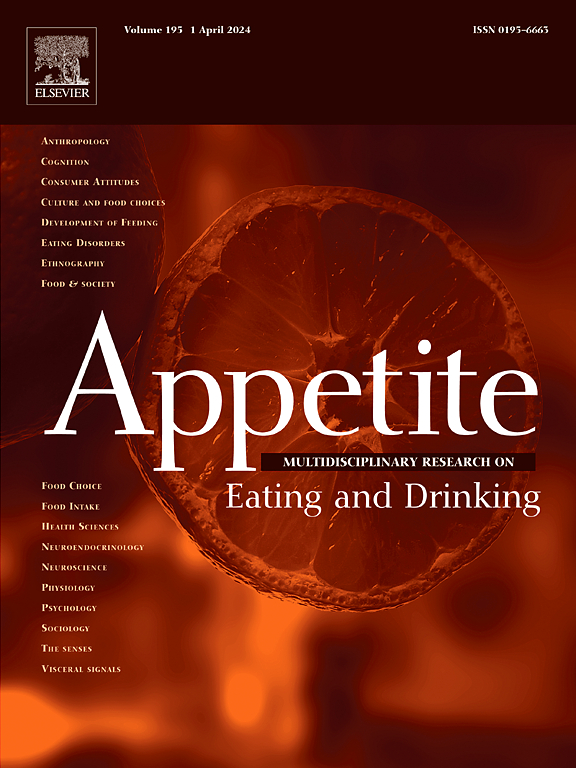家庭如何应对粮食不安全?乌拉圭有子女参加公共托儿服务家庭应对策略的定量分析。
IF 3.8
2区 医学
Q1 BEHAVIORAL SCIENCES
引用次数: 0
摘要
粮食不安全仍然是一个紧迫的全球挑战,特别是对有孩子的家庭而言。本研究考察了拉丁美洲高收入国家乌拉圭有3岁以下儿童的社会经济弱势家庭所采取的应对策略,实现了以下目标:(一)估计不同应对策略的频率,(二)评估这些策略与感知到的粮食不安全的关系,以及(三)分析社会经济因素对其使用的影响。在有孩子在公立托儿中心的家庭中进行了一项具有全国代表性的调查(n=1535)。问卷包括粮食不安全体验量表和一套15应对策略,这些策略来自先前的定性研究。调查结果显示,72%的家庭在调查前一年至少采取过一种应对策略。采用每种策略的可能性因家庭所经历的粮食不安全程度而异。Rasch模型表明,应对策略可以沿着一个单维的严重性连续体来表示:当食物短缺出现时,较不严重的策略会被较早地采用,而更严重的策略只会在更极端的条件下出现。除粮食不安全外,社会经济地位和教育水平也是使用若干战略的重要预测因素。这些结果表明,应对策略和粮食不安全指标反映了获取粮食的经济挑战的不同但相互关联的方面。值得注意的是,一些应对策略甚至在轻度粮食不安全和粮食安全的家庭中也非常普遍,这可能意味着儿童饮食质量的负面变化。本文章由计算机程序翻译,如有差异,请以英文原文为准。
How do households cope with food insecurity? Quantitative analysis of the coping strategies of households with children attending public childcare in Uruguay
Food insecurity remains a pressing global challenge, particularly for households with children. This study examined the coping strategies adopted by socioeconomically vulnerable households with children up to 3 years old in Uruguay, a high-income Latin American country, by addressing the following objectives: (i) estimate the frequency of different coping strategies, (ii) assess their relationship with perceived food insecurity, and (iii) analyze the influence of socio-economic factors on their use. A nationally representative survey was conducted among households with children attending public childcare centers (n = 1535). The questionnaire included the Food Insecurity Experience Scale and a set of 15 coping strategies derived from prior qualitative research. The findings revealed that 72 % of households had adopted at least one coping strategy in the year prior to the survey. The likelihood of employing each strategy varied with the level of food insecurity experienced by the household. The Rasch model suggested that coping strategies can be represented along a unidimensional continuum of severity: less severe strategies are adopted earlier as food shortages appear, while more severe strategies appear only under more extreme conditions. In addition to food insecurity, socio-economic status and education level were also significant predictors of the use of several strategies. These results suggest that coping strategies and food insecurity indicators capture distinct yet interconnected aspects of economic challenges to access food. Notably, some coping strategies were highly prevalent even among households experiencing mild food insecurity and food security, which may imply negative changes in children's diet quality.
求助全文
通过发布文献求助,成功后即可免费获取论文全文。
去求助
来源期刊

Appetite
医学-行为科学
CiteScore
9.10
自引率
11.10%
发文量
566
审稿时长
13.4 weeks
期刊介绍:
Appetite is an international research journal specializing in cultural, social, psychological, sensory and physiological influences on the selection and intake of foods and drinks. It covers normal and disordered eating and drinking and welcomes studies of both human and non-human animal behaviour toward food. Appetite publishes research reports, reviews and commentaries. Thematic special issues appear regularly. From time to time the journal carries abstracts from professional meetings. Submissions to Appetite are expected to be based primarily on observations directly related to the selection and intake of foods and drinks; papers that are primarily focused on topics such as nutrition or obesity will not be considered unless they specifically make a novel scientific contribution to the understanding of appetite in line with the journal's aims and scope.
 求助内容:
求助内容: 应助结果提醒方式:
应助结果提醒方式:


